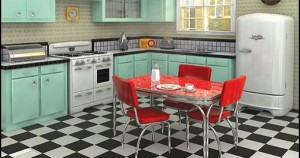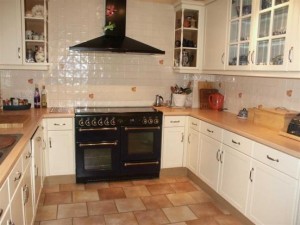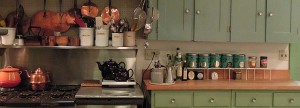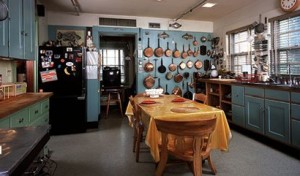“…But the kitchen will not come into its own again until it ceases to be a status symbol and becomes again a workshop… [and] you and I will know it chiefly by its fragrances and its clutter. It won’t be neat. It won’t even look efficient. but when you enter it you will feel the pulse of life throbbing from every corner. The heart of the home will have begun once again to beat.” ― Phyllis McGinley, American poet and author
I grew up in just such a kitchen: the workshop kind. Cluttered. Chaotic. Cupboard doors hanging open. Littered surfaces. Leftovers turning into chemistry experiments at the back of the fridge. I recognize all the signs. A pot of soup, regularly topped up with last night’s vegetables, sat on the back of the stove all winter, socks and underpants drying in the warming drawer, the almost visible smell of orange cake wafting from the oven and down the passage.
Everyone congregated in our kitchen – friends, family, workmen, complete strangers sometimes – perching on low stools around the kitchen table or leaning against counter tops. And our mother was ever the centrepiece, chatting, laughing, always active: baking biscuits or cakes; topping up the soup or burning the saucepans dry; chopping, peeling, stirring, and making endless mugs of Nescafé; knitting a jumper or doing the daily crossword, surrounded by small mountains of reference books; exploring cookery books that had been liberally baptized in flour, butter or gravy.
A round table stood in in the middle of the room and would always be scattered with letters, car keys, mugs, ashtrays, spoons, elbows, sugar bowls and inevitably a raggle-taggle posy of flowers gathered from the garden and stuffed in a small, chipped vase. An old dresser stood by the door – it has stood there for almost fifty years – accumulating all the family detritus. The drawers were stuffed with loose photos, flat batteries, secateurs, screwdrivers, shoe polish. The cupboards were crammed with plastic containers, odd saucepans with mix and not-matching lids, bent and dented roasting trays and assortments of home-made jams and chutneys, some of which had lurked there for years. On top of the dresser cake and biscuit tins would be stacked, supposedly out of the reach of a hoard of vertically challenged, ravenous children, but we were like mountain goats and learned to scale that cupboard from an early age. The heart of the home? Always. The pulse of life? Absolutely. This kitchen was never ‘designed’ by any stretch of the imagination, it just was, and it was always warm and welcoming.
spoons, elbows, sugar bowls and inevitably a raggle-taggle posy of flowers gathered from the garden and stuffed in a small, chipped vase. An old dresser stood by the door – it has stood there for almost fifty years – accumulating all the family detritus. The drawers were stuffed with loose photos, flat batteries, secateurs, screwdrivers, shoe polish. The cupboards were crammed with plastic containers, odd saucepans with mix and not-matching lids, bent and dented roasting trays and assortments of home-made jams and chutneys, some of which had lurked there for years. On top of the dresser cake and biscuit tins would be stacked, supposedly out of the reach of a hoard of vertically challenged, ravenous children, but we were like mountain goats and learned to scale that cupboard from an early age. The heart of the home? Always. The pulse of life? Absolutely. This kitchen was never ‘designed’ by any stretch of the imagination, it just was, and it was always warm and welcoming.
As an adult, I have moved house uncountable times over the years, and each time I have to start house-hunting again, I write a hit list of everything I want and need in our next abode. Each time number one on the list is: ‘a decent kitchen.’ And yet, inevitably, it is the kitchen that doesn’t make the grade. In retrospect, I guess I have always been attempting to replicate the atmosphere of our childhood kitchen – maybe not the clutter, but at least the pulse. Often I blame the details: no hot water on tap; cheap and nasty electric ovens; negligible storage space. There have been kitchens where the counter-tops were so low that even hobbits would have to stoop uncomfortably to chop or wash up. And there have been those suffocatingly hot kitchens in the Tropics with no air-conditioning, because ma’am doesn’t belong in the kitchen anyway. Occasionally we have even had smart, designer kitchens that are frightfully efficient, even pretty, and yet I never felt they exuded the warmth of my mother’s kitchen. And mostly, I suspect, for want of a kitchen table.
 When we finally bought a house in England, the kitchen was awful. It was an 8’ x 10’ space hampered by three doorways. The cupboard space was severely limited by the unwelcome presence of a boiler, a dishwasher, a washing machine and a tumble dryer. Tiny bite-sized slices of counter space were scattered round the walls in the most ineffectual arrangement that was ever invented. We eventually gutted and redesigned it, and I absolutely loved what we created, but it never actually expanded to fit a table.
When we finally bought a house in England, the kitchen was awful. It was an 8’ x 10’ space hampered by three doorways. The cupboard space was severely limited by the unwelcome presence of a boiler, a dishwasher, a washing machine and a tumble dryer. Tiny bite-sized slices of counter space were scattered round the walls in the most ineffectual arrangement that was ever invented. We eventually gutted and redesigned it, and I absolutely loved what we created, but it never actually expanded to fit a table.
At the moment I have a pocket-sized kitchen in an open plan apartment (never again) with counter space that even the cockroaches find limiting. What’s more, it has been designed – and I use the term loosely – by someone who has never stepped foot in a kitchen. Despite the minimalist space, I still have a tendency to clutter surfaces with pots of utensils and boxes of tea and toasters and chopping boards, because I love having things to hand. Luckily, I have never been one for gadgets, because, seriously, there is barely room for the toaster. And the maid’s room has become my pantry, in which I store every over-sized saucepan or useless utensil I cannot bring myself to throw away, because I may need it at some undetermined point in the future.
Nonetheless, needs must, and I am learning how to cook without elbows and how to clear up as I go, although I would kill for a dishwasher in which to tuck all those mugs and plates and glasses out of sight. Of course there are only two of us now, so I am downsizing my pots and pans and trying not to cook every meal for five. I am getting the hang of it, but I find I miss the neatly stacked ice cream tubs full of leftover pasta sauces and curry in the freezer, marked in marker pens as “soup” – or not marked and assumed to be ice-cream, until it isn’t. The good part is, my cook books are at hand, although much to my chagrin I have inherited the messy cook gene, so there are remnants of every recipe I have ever attempted decorating the pages.
In postwar America, the modern kitchen was designed to tempt women back into ‘the heart’ of the suburban family home and away from their war work in factories and offices. The modern kitchen was stocked with every possible labour-saving appliance. It was often merged into the family’s living space. The modern kitchen did indeed become a status symbol and there it has remained. Today, my modern, technology-friendly girlfriends boast of something called a Thermomix and invest in high tech juicers. Others have those glorious retro cake-mixers reigning over the counter tops. At least one friend has even invested in a Thermomix and the most amazing space age kitchen in which the meals seem to virtually cook themselves in moments. It’s like magic!
 Call me perverse, but I honestly prefer my muddled, mixed-up workshop kitchen with its awkward corners and it’s ridiculous, impractical design – although I admit, I do occasionally dream of something more in the vein of Julia Child’s simple, homely Massachusetts kitchen, its shelves choc-a-block with pots and pans and jugs and jars. And I do wish there was room for a kitchen table. Then, like Julia’s or my mother’s kitchens, it might just become “the most loved and most used room in the house.”
Call me perverse, but I honestly prefer my muddled, mixed-up workshop kitchen with its awkward corners and it’s ridiculous, impractical design – although I admit, I do occasionally dream of something more in the vein of Julia Child’s simple, homely Massachusetts kitchen, its shelves choc-a-block with pots and pans and jugs and jars. And I do wish there was room for a kitchen table. Then, like Julia’s or my mother’s kitchens, it might just become “the most loved and most used room in the house.”
*With thanks to Google Images for the kitchen pics.

